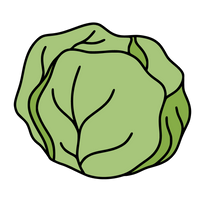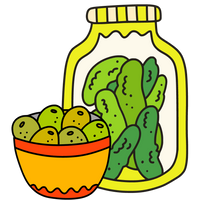
Chances are you've been hearing a lot more about sauerkraut lately. You've probably even heard that sauerkraut is good for your gut health.
Are you wondering “is sauerkraut healthy?” If you ate that soggy, ghastly, acidic stuff as a kid and have never looked back, keep reading because we have some good news for you.
Here at Olive My Pickle, we've been making sauerkraut for 12+ years. Each Saturday at the farmer's market, we meet people that say, "hate kraut, always have." Then we ask them to try some of ours, and guess what? They experience something completely new and different than what they've always thought kraut to be. Why is that?
 In this article, we''ll cover the basics about sauerkraut:
In this article, we''ll cover the basics about sauerkraut:
- Is sauerkraut good for you?
- Why is sauerkraut good for gut health?
- What are the health benefit of cabbage and sauerkraut?
- Does sauerkraut have vinegar in it?
- What is different and better about fermented kraut?
- If kraut is so good for me, can I learn to love it?
We'll answer these questions and more.

What is sauerkraut?
First, what is sauerkraut? The simplest answer is that sauerkraut is fermented cabbage. Okay, so what does that mean?
If you are a kraut hater, this is an especially important point.
That's because the soggy, stinky, acidic stuff you ate (and hated) as a kid, is NOT fermented sauerkraut.
That gross kraut is made with vinegar, then cooked to kill all of the beneficial bacteria. In the process the raw cabbage turns soggy, and the vinegar creates a very strong, sour flavor.
How do fermented foods, and the fermentation process of cabbage compare?
Rather than cook the cabbage, fermentation simply adds sea salt to shredded cabbage. The salt naturally removes the moisture from the cabbage leaves, creating sauerkraut juice.
Over the course of several days, the natural fermentation process transforms the raw cabbage into fermented sauerkraut.
How does fermented sauerkraut compare to vinegar sauerkraut?
A common question is, does sauerkraut have vinegar in it?
As we've explained above, it depends on the process used to create the sauerkraut.
Mostly all sauerkrauts you find in the store are the cooked, vinegar based ones.
It can be hard to find naturally fermented sauerkraut, but luckily you're in the right place. We have five delicious varieties of fermented kraut. Our Carrot + Dill and Classic Caraway are perfect for beginners, yet our Red + Ginger, Turmeric + Cumin, and Heat + Spicy are fan favorites as well. All of these varieties are easy to integrate into your healthy habits and onto your healthy plates.
Check out our variety of delicious, fermented krauts here at Olive My Pickle.
How does fermented kraut stand in a taste comparison to vinegar kraut?
Fermented kraut has a much more fresh and crisp texture, like a slaw. Flavor wise, because fermented kraut is made with high mineral sea salt, it is somewhat salty, although not overpoweringly so. Any ferment will derive much of its flavor from the fermentation process itself, which creates a deep, complex and delicious umami flavor, in addition to its saltiness.
How do you turn unfermented cabbage into kraut?
Again, the answer is the process of fermentation. Beyond salt, a fermenting batch of sauerkraut needs a few things in order to turn out delicious.
If you make your own sauerkraut, you know how important the basics are to get right.

You'll need a clean vessel, preferably glass. You'll need to create an aerobic environment (i.e. oxygen free) within the glass jar. This can be accomplished through the use of a weight and/or an airlock. Once the fermentation process has kicked off, within a few days the lack of oxygen and the salt levels will kill off the harmful bacteria in the ferment, and the good, probiotic bacteria will begin to proliferate in your sauerkraut fermentation.
Within a few weeks your batch will be done. Length of time depends on the temperature you ferment at, somewhere around 70 degreed Fahrenheit is optimal, any cooler and the fermentation will progress very slowly.
After you deem the batch to be complete, you'll stick it in the refrigerator. A batch of fermented cabbage will keep for a very long time, after all its been preserved through the fermentation process.
To read a more in depth article about the process of fermentation, and how cabbage can be transformed to sauerkraut, read Fermentation Defined.
 Where did sauerkraut come from? A brief history and heritage of sauerkraut
Where did sauerkraut come from? A brief history and heritage of sauerkraut
Most people associate kraut with a German tradition, however it spans beyond that. (The word for cabbage in German is kraut.)
In China, the benefits of sauerkraut have long been known where fermenting cabbage has been occurring for thousands of years. According to lore, the lactic acid fermentation process was first discovered during the building of the Great Wall of China. Workers did not own individual dishes, so they dumped their fresh cabbage into one big crock, creating the very first batch of fermented cabbage.
As early as 200 BC there are writings from China of recipes for pickling cabbage in wines and using it as a condiment. We find the first writings on the process of fermentation date back to Roman times, in 50 AD by the scholar Pliny. Other examples of fermentation throughout history:
-
In 25 BC Roman Emperor Tiberius carried barrels of sauerkraut and fermented foods on excursions to the Middle East.
-
Cabbage was cultivated for fermentation in ancient Greece, where the Greek physician Dioscurides wrote of cabbage, "it is healthier if only warmed than cooked." It was understood even then that kraut's health proprieties and benefit to the immune system were stronger when eaten raw.
-
Around 1200, Ghengis Khan travelled west to conquer the eastern portions of Europe, bringing fermented kraut, sour cabbage, with him. Because of his conquests, the Slavic tradition of fermenting cabbage (and the name sauerkraut) was born.
Perhaps one of the largest impacts of sauerkraut on the development of the western world was its use during the 18th century on the high seas.
Sailors understood that eating sauerkraut, which is especially high in vitamin C, was effective on staving off scurvy. In fact, Captain Cook sailed around the entire world for three years not losing a single crew member to scurvy, thanks to sauerkraut.
What do all of these early accounts of unpasteurized sauerkraut have in common?
All of the kraut written about in the history books is the fermented kind, that which is made with salt water brine and not vinegar.
Indeed it is one of the oldest traditional foods with long known healing properties, perhaps the very first health food.
The unique health benefits of cabbage and sauerkraut
Raw cabbage is incredibly healthy stuff! And its important to realize that the health benefits of any vegetable increases and compounds after undergoing the process of fermentation.
Loaded with both vitamin C and vitamin K, cabbage also contains small amounts of other micronutrients, including vitamin A, iron, and riboflavin.
Cabbage is rich in vitamin B6 and both cabbage and sauerkraut are high in folate, both of which are essential for many important processes in the body, including energy metabolism and the normal functioning of the nervous system.
Sauerkraut contains beneficial nutrients, including antioxidants.
Cabbage and kraut are also anti-inflammatory, studies show that consumption of cruciferous vegetables, cabbage among them will lower inflammatory markers when eaten consistently over time.
Sauerkraut benefits digestion
To keep your digestive system happy and healthy, eat plenty of kraut! Kraut is key for healthy gut because of its fiber, live cultures and enzymes. Here's why sauerkraut is a gut health superfood:
FIBER
Kraut is rich in insoluble fiber-- the type of fiber that doesn't break down and get absorbed, and which acts like a broom within the gut. But it doesn't stop there-- kraut is also a rich source of prebiotic fiber -- also known as soluble fiber. This is the type of fiber that the resident bacteria in your gut eat.
LIVE BACTERIA
The probiotic benefits of sauerkraut are numerous. Kraut is key for healthy gut because of its lactic acid bacteria, which is incredibly beneficial for gut health and the immune system. Not only that, kraut juice is especially concentrated in these beneficial probiotic bacteria, so be sure to drink that stuff and never dump it down the drain!
LIVE ENZYMES
Fermented foods and sauerkraut are enzyme rich. Why does this matter? Your body devotes 70% of its energy to the process of digestion. It digests food with a bank of digestive enzymes. When you supplement your enzymes with food enzymes like those found in ferments, you help your body store energy so it can be used for other things.
The benefits of live enzymes found in sauerkraut may be one of the least recognized health benefits of fermented foods.
Indeed, sauerkraut’s health benefits are numerous! For a more in-depth article, read The 7 Principal Health Benefits of Fermented Food.

Can I learn to love sauerkraut?
We started this article talking about that depressing, grey sauerkraut that was always on the table at the family picnic growing up. Maybe it came out of a can or a plastic bag-- either way it was gross!
We're happy to tell you that this is not authentically fermented kraut. In fact, the experience of eating naturally fermented kraut is completely different.
-
Fermented kraut is mellower. Fermented kraut is preserved with salt water and not vinegar. The result is a much less acidic "punch in the face" effect.
-
Fermented kraut has a much more complex and interesting flavor than that pasteurized canned, jarred or bagged kraut from the grocery store. That's because the fermentation process itself creates a deep umami flavor. Frankly its delicious.
-
The texture of fermented kraut is much more appealing. It's crisper and fresher, more like slaw.
You owe it to yourself to try fermented kraut and get to know its subtleties, its strengths and its complexity. Take it from us: we've converted thousands of doubters into fans over the years after introducing people to true fermented kraut!
How much sauerkraut do I need to eat to get the benefits?
If you're looking to improve your digestive health and achieve healthy gut flora with fermented food, we have good news: its pretty easy. And delicious.
We advocate eating fermented foods three times a day, every day. Eating ferments is a lifestyle, not a fad or a phase.
Our customers that have achieved gut health success with ferments have committed to them as a lifelong habit.
The key is getting enough variety to keep this habit interesting. That's exactly why we developed a product line of over 40 products: because we know it's a commitment to a lifestyle and having plenty of variety to choose from will make healthy habit easier to stick with.
Our customers have found that a strong digestive system and healthy immune system is possible with a commitment to these good habits over time.
To make those good habits stick, we constantly making introductions of short term seasonal ferments for you to try. Our community of customers (and their gut microbiome) thank us!

What are the Benefits of Eating Beneficial Bacteria Daily?
Eating sauerkraut daily can deliver certain health benefits. A 2021 study at Stanford University, concluded that the daily consistent introduction of ferments improved immunity markers in a health cohort of study participants.
At OMP, we hear feedback from customers every day about how adding sauerkraut and fermented food to their daily diets has benefited their health.
What are the best ways to eat sauerkraut?
To enjoy kraut, its best not to overthink it!
Although many people associate with putting kraut on a hot dog, there are so many more ways to enjoy it. Sauerkraut really is the most versatile of any fermented vegetable. Just a few ways to enjoy kraut include:
-
Next to your eggs in the morning
-
Avocado toast topped with finely chopped sauerkraut
-
Put it into your salad at lunch
-
Enjoy an easy salad dressing of kraut juice and extra virgin olive oil
-
Use kraut as a topping in your cheese and/or lunch meat sandwich
-
Garnish any dinner plate with a bite of kraut
It's easy to get the delicious taste and beneficial bacteria from kraut with any meal throughout the day and to eat sauerkraut on a regular basis is simple.

In Conclusion: Sauerkraut has Numerous Health Benefits
By now you've come to understand the difference between vinegar based sauerkraut and the healthy, fermented kraut with higher nutritional value.
Indeed, eating probiotic foods like kraut on a regular basis is not only easy and enjoyable, it's a great way to improve the health of your digestive tract and overall health.
As future research on the connection between brain health and healthy gut flora emerges, and food science processes, science will continue to confirm what our ancestors and history intuitively knew: that the benefits of sauerkraut are many.
Reap the benefits of eating sauerkraut daily by finding delicious recipes that include sauerkraut on our blog.












